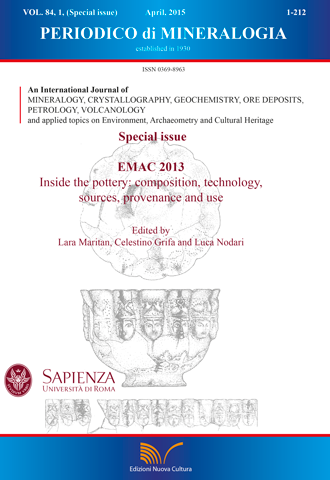Lustre and glazed ceramic collection from Mas Llorens, 16th-17th centuries (Salt, Girona) Provenance and technology
DOI:
https://doi.org/10.2451/2015PM0004Keywords:
, tluster, tin glaze, post-medieval, Catalonia, NAA, SEMAbstract
Luster pottery unearthed at Mas Llorens, a fortified house documented since the 13th century onwards in the city of Salt (Girona), constitutes one of most interesting collections of late 16th and early 17th centuries luster pottery from Catalonia. The collection is formed by an unparalleled set of more than 200 complete dishes and bowls, which were buried in the same place and at the same moment, then becoming of paramount archaeological interest. Therefore, this set of luster pottery has become of pivotal importance for the study of this type of ceramic not only because of the number and integrity of the pieces that were found, but also by its homogeneity. This multidisciplinary study has revealed the importance of this pottery in terms of economy, trade, and social status in Modern times Catalonia. The main purpose of this paper is to determine provenance and technology of production of luster and other glazed samples from Mas Llorens. We present the results of the archaeometrical characterization of 21 ceramic sherds, recovered from the excavations of Mas Llorens. The sample includes 11 luster ceramics, 4 blue-on-white tin-lead-glazed ceramics, and 6 plain lead glazed productions. The chemical and mineralogical composition of pastes ceramics have been analyzed by FRX, NAA, and DRX, and statically compared against 16th-17th tin-lead glazed pottery produced by the main Catalan workshops at that time (e.g. Barcelona, Reus, Vilafranca del Penedès). The chemical data show a high homogeneity in the composition of luster pastes, as seen in other proto-industrial fine ceramic productions, evidencing a likely Barcelonan provenance. Chemical composition and microstructures of the glazes were observed and studied by electron microscopy (SEM), Electron Probe microanalyses (EPMA) and Elastic ion backscattering spectroscopy (EIBS). Good luster exhibits red-copper color and metallic shine and contain more copper than silver. In these cases copper and silver nanoparticles are concentrated in a thin layer very near to the surface, meanwhile brown luster without metallic shine contain copper nanoparticles distributed in a thicker layer, and silver is concentrated on top of the luster layer. The lack of metallic shine in those samples is explained by the low silver and copper concentration in this thick layer. This may be related to a longer firing and, consequently, to a not strong and efficient reduction that stop the diffusion of copper into the glaze.


